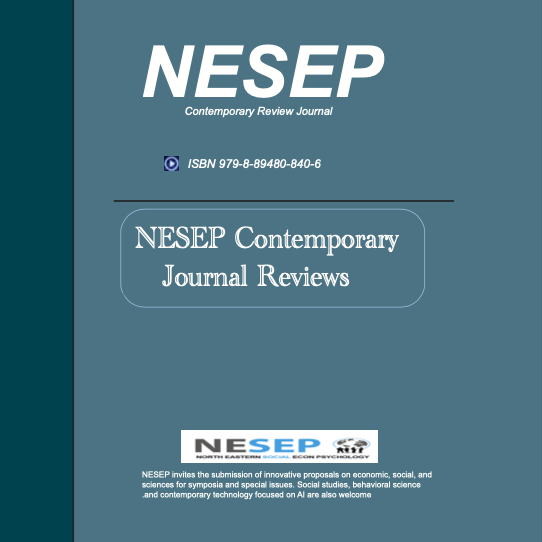Featured Issues
Below are compilations of selected work related to a contemporary matter area.

Palma, Spain. 6/30~7/2, 2025.
ISBN 2: 979-8-89480-848-2
Annual Conference
Publisher: NESEP
The Effect of Age on Short-Term Memory: In-Person and Online
Abstract: Memory is in the hippocampus, the center for learning. With increasing age, the hippocampus has fewer neuronal connections leading to weaker memory. 65% of adults 65+ suffer with memory. 1% progress onto serious impairments. Previous studies suggest age hinders memory, however, it’s not well understood how short-term memory assessment methods (i.e. in-person vs. online) varies across age. This study investigated whether age affected short-term memory in an in-person versus an online setting. This study gathered 10 individuals across three age groups, ages 12-15 (n=5), 42-52 (n=3), and 72-76 (n=2). To assess short-term memory, an in-person and online exam were conducted. The in-person exam was a matching game where 20 matching pairs were laid in front of participants. Participants had 20 seconds to memorize the card’s location, until flipped over. The participants had to find the most pairs in 30 seconds. The online test analyzed working memory through remembering numbers. The 12-15 age group had an average of 3.7 cards remembered on the in-person exam, compared to averages of 2.1 and 2.7 cards from the middle and older groups, respectively. The 42-52 age group had an average of 100.3 on the online exam compared to averages of 94.6 and 66.5 points from the younger and older groups, respectively. These findings suggest younger people have better visual memory, but middle-aged people have better working memory. This data could lead to a better understanding of neurological conditions across all ages such as Dementia.
References
-
Arey, R. N., & Murphy, C. T. (2017). Conserved regulators of cognitive aging: From worms to humans. Behavioral Brain Research, 322, 299–310. https://doi.org/10.1016/j.bbr.2016.06.035
-
Chen, Z., Zhang, Y., Yu, Y., Che, Y., Jin, L., Li, Y., Li, Q., Li, T., Dai, H., & Yao, J. (2021). Corrigendum to “write once read many times resistance switching memory based on all inorganic perovskite CSPBBR3 quantum dots.” Optical Materials, 112, 110756. https://doi.org/10.1016/j.optmat.2020.110756
-
Hendrickx, J. O., De Moudt, S., Callus, E., De Deyn, P. P., Van Dam, D., & De Meyer, G. R. Y. (2022). Age-related cognitive decline in spatial learning and memory of C57BL/6J MICE. Behavioral Brain Research, 418, 113649. https://doi.org/10.1016/j.bbr.2021.113649
-
How, C. M., Lin, T.-A., & Liao, V. H.-C. (2021). Early-life chronic di(2-ethylhexyl)phthalate exposure worsens age-related long-term associative memory decline associated with insulin/IGF-1 signaling and CRH-1/CREB in Caenorhabditis elegans. Journal of Hazardous Materials, 417, 126044. https://doi.org/10.1016/j.jhazmat.2021.126044
-
Javaid, H., Manor, R., Kumarnsit, E., & Chatpun, S. (2021). Decision tree in working memory tasks effectively characterizes EEG signals in healthy aging adults. IRBM. https://doi.org/10.1016/j.irbm.2021.12.001
-
Kingo, O. S., Sonne, T., & Krøjgaard, P. (2022). Predicting explicit memory for meaningful cartoons from visual paired comparison in infants and toddlers. Journal of Experimental Child Psychology, 215, 105316. https://doi.org/10.1016/j.jecp.2021.105316
-
Roodenrys, S., Miller, L. M., & Josifovski, N. (2022). Phonemic interference in short-term memory contributes to forgetting but is not due to overwriting. Journal of Memory and Language, 122, 104301. https://doi.org/10.1016/j.jml.2021.104301
-
Schworer, E. K., Voth, K., Hoffman, E. K., & Esbensen, A. J. (2022). Short-term memory outcome measures: Psychometric Evaluation and performance in youth with down syndrome. Research in Developmental Disabilities, 120, 104147. https://doi.org/10.1016/j.ridd.2021.104147
-
Serra, F. T., Cardoso, F. dos, Petraconi, N., dos Santos, J. C., Araujo, B. H., Arida, R. M., & Gomes da Silva, S. (2021). Resistance exercise improves learning and memory and modulates hippocampal METABOLOMIC profile in aged rats. SSRN Electronic Journal. https://doi.org/10.2139/ssrn.3951406
-
Wong, L.-W., Wang, Z., Ang, S. R., & Sajikumar, S. (2022). Fading memories in aging and neurodegeneration: Is P75 neurotrophin receptor a culprit? Aging Research Reviews, 75, 101567. https://doi.org/10.1016/j.arr.2022.101567